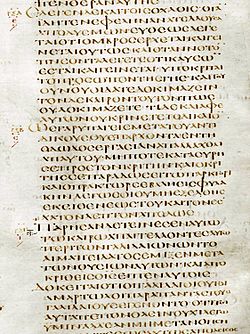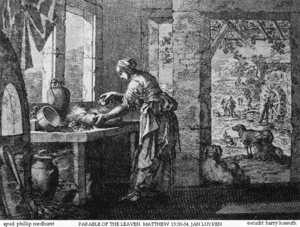
The Tower of Siloam was a structure which fell upon 18 people, killing them. Siloam is a neighborhood south of Jerusalem's Old City. In the Gospel of Luke, Jesus refers to the tower's collapse and the death of the 18 in a discourse on the need for individual repentance for sin. The incident is mentioned only once in the New Testament, in Luke 13:4, as part of a section with examples inviting repentance contained in verses 13:1–5.

Mark 11 is the eleventh chapter of the Gospel of Mark in the New Testament of the Christian Bible, beginning Jesus' final "hectic" week, before his death as he arrives in Jerusalem for the coming Passover. It contains the stories of Jesus' entry into Jerusalem, his cursing of the fig tree, his conflict with the Temple money changers, and his argument with the chief priests and elders about his authority. Biblical commentator Christopher Tuckett notes that "the Passion narrative in Mark is usually adjudged to start at chapter 14, but there is a real sense in which it can be said to start ... at the start of chapter 11".
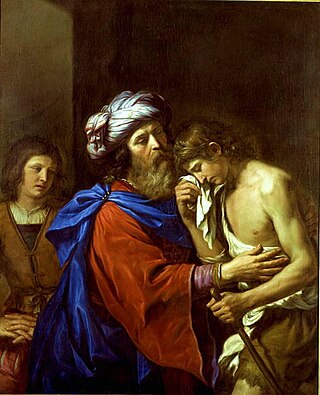
The parables of Jesus are found in the Synoptic Gospels and some of the non-canonical gospels. They form approximately one third of his recorded teachings. Christians place great emphasis on these parables, which they generally regard as the words of Jesus.

Luke 4 is the fourth chapter of the Gospel of Luke in the New Testament of the Christian Bible, traditionally attributed to Luke the Evangelist, a companion of Paul the Apostle on his missionary journeys. This chapter details Jesus' three temptations, the start of his "Galilean Ministry", and his rejection at Nazareth, which Luke contrasts with his acclaim in nearby Capernaum.

Matthew 13 is the thirteenth chapter in the Gospel of Matthew in the New Testament section of the Christian Bible. Verses 3 to 52 of this chapter form the third of the five Discourses of Matthew, called the Parabolic Discourse, based on the parables of the Kingdom. At the end of the chapter, Jesus is rejected by the people of his hometown, Nazareth.
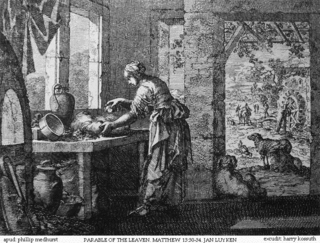
The Parable of the Leaven, also called the parable of the yeast, is one of the shortest parables of Jesus. It appears in Matthew 13:33 and Luke 13:20–21, as well as in the non-canonical Gospel of Thomas. In the canonical gospels it immediately follows the Parable of the Mustard Seed, which shares this parable's theme of the Kingdom of Heaven growing from small beginnings. In the Gospel of Thomas it starts a series of three, preceding the Parable of the empty jar and the Parable of the Strong Man.

Mark 13 is the thirteenth chapter of the Gospel of Mark in the New Testament of the Christian Bible. It contains Jesus' predictions of the destruction of the Temple in Jerusalem and disaster for Judea, as well as Mark's version of Jesus' eschatological discourse. Theologian William Barclay described this chapter as "one of the most Jewish chapters in the Bible" and "one of the most difficult chapters in the New Testament for a modern reader to understand".

The ministry of Jesus, in the canonical gospels, begins with his baptism in the countryside of Roman Judea and Transjordan, near the River Jordan by John the Baptist, and ends in Jerusalem, following the Last Supper with his disciples. The Gospel of Luke states that Jesus was "about 30 years of age" at the start of his ministry. A chronology of Jesus typically sets the date of the start of his ministry at around AD 27–29 and the end in the range AD 30–36.
Matthew 16 is the sixteenth chapter in the Gospel of Matthew in the New Testament section of the Christian Bible. Jesus begins a journey to Jerusalem from the vicinity of Caesarea Philippi, near the southwestern base of Mount Hermon. Verse 24 speaks of his disciples "following him".
John 9 is the ninth chapter of the Gospel of John in the New Testament of the Christian Bible. It maintains the previous chapter's theme "Jesus is light", recording the healing of a man who had been blind from birth, a miracle performed by Jesus, and their subsequent dealings with the Pharisees. The man born blind comes to complete faith in Jesus, while some of the Pharisees remain in their sin. The author of the book containing this chapter is anonymous, but early Christian tradition uniformly affirmed that John composed this Gospel.

Luke 5 is the fifth chapter of the Gospel of Luke in the New Testament of the Christian Bible, traditionally attributed to Luke the Evangelist, a companion of Paul the Apostle on his missionary journeys. The chapter relates the recruitment of Jesus' first disciples and continues to describe Jesus' teaching and healing ministry. Early criticism from the Jewish religious authorities is encountered as the chapter progresses.

Luke 6 is the sixth chapter of the Gospel of Luke in the New Testament of the Christian Bible, traditionally attributed to Luke the Evangelist, a companion of Paul the Apostle on his missionary journeys. Jesus' teaching about the Sabbath enrages the religious authorities and deepens their conflict. The selection of twelve apostles is recounted and this is followed by the "Sermon on the Plain", where key aspects of Jesus' teaching are presented.
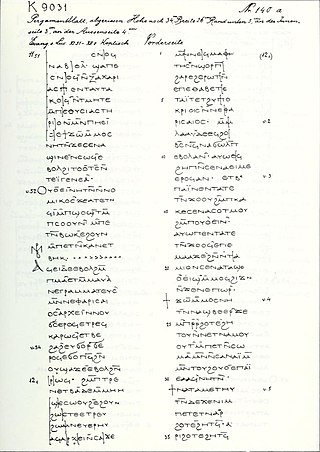
Luke 12 is the twelfth chapter of the Gospel of Luke in the New Testament of the Christian Bible. It records a number of teachings and parables told by Jesus Christ when "an innumerable multitude of people had gathered together", but addressed "first of all" to his disciples. The book containing this chapter is anonymous, but early Christian tradition uniformly affirmed that Luke the Evangelist composed this Gospel as well as the Acts of the Apostles.

Luke 14 is the fourteenth chapter of the Gospel of Luke in the New Testament of the Christian Bible. It records one miracle performed by Jesus Christ on a Sabbath day, followed by His teachings and parables. The book containing this chapter is anonymous, but early Christian tradition uniformly affirmed that Luke the Evangelist composed this Gospel as well as the Acts of the Apostles.

Luke 15 is the fifteenth chapter of the Gospel of Luke in the New Testament of the Christian Bible. The book containing this chapter is anonymous, but early Christian tradition uniformly affirmed that Luke the Evangelist composed this Gospel as well as the Acts of the Apostles. This chapter records three parables of Jesus Christ: the lost sheep, the lost coin and the lost or 'prodigal' son, a trilogy about redemption that Jesus tells after the Pharisees and religious leaders accuse him of welcoming and eating with "sinners".

Luke 17 is the seventeenth chapter of the Gospel of Luke in the New Testament of the Christian Bible. It records the teachings of Jesus Christ and the healing of ten lepers. The book containing this chapter is anonymous, but early Christian tradition uniformly affirmed that Luke the Evangelist composed this Gospel as well as the Acts of the Apostles.

Luke 19 is the nineteenth chapter of the Gospel of Luke in the New Testament of the Christian Bible. It records Jesus' arrival in Jericho and his meeting with Zacchaeus, the parable of the minas and Jesus' arrival in Jerusalem. The book containing this chapter is anonymous, but early Christian tradition uniformly affirmed that Luke the Evangelist composed this Gospel as well as the Acts of the Apostles.
Luke 20 is the twentieth chapter of the Gospel of Luke in the New Testament of the Christian Bible. It records the teaching of Jesus Christ in the temple in Jerusalem, especially his responses to questions raised by the Pharisees and Sadducees. The book containing this chapter is anonymous, but early Christian tradition uniformly affirmed that Luke the Evangelist composed this Gospel as well as the Acts of the Apostles.

Luke 21 is the twenty-first chapter of the Gospel of Luke in the New Testament of the Christian Bible. It records the observations and predictions of Jesus Christ delivered in the temple in Jerusalem. The book containing this chapter is anonymous, but early Christian tradition uniformly affirmed that Luke the Evangelist composed this Gospel as well as the Acts of the Apostles.

The cursing of the fig tree is an incident reported in the Synoptic Gospels, presented in Mark and Matthew as a miracle in connection with the entry into Jerusalem, and in Luke as a parable. The image is taken from the Old Testament symbol of the fig tree representing Israel, and the cursing of the fig tree in Mark and Matthew and the parallel story in Luke are thus symbolically directed against the Jews, who have not accepted Jesus as Messiah. The gospel of John omits the incident entirely and shifts the event with which it is connected, the cleansing of the temple, from the end of Jesus' career to the beginning.
